Albino Ball Pythons: 13 Cool Facts
Ball pythons are extremely popular in the herpetology world, perhaps one of the most popular, in fact. The only thing more popular than a plain Jane ball python would have to be an albino ball python. Here are 13 unique facts you can use to win the next pop quiz at the bar this weekend (or maybe you just want to look cool, but I’m not one to judge).
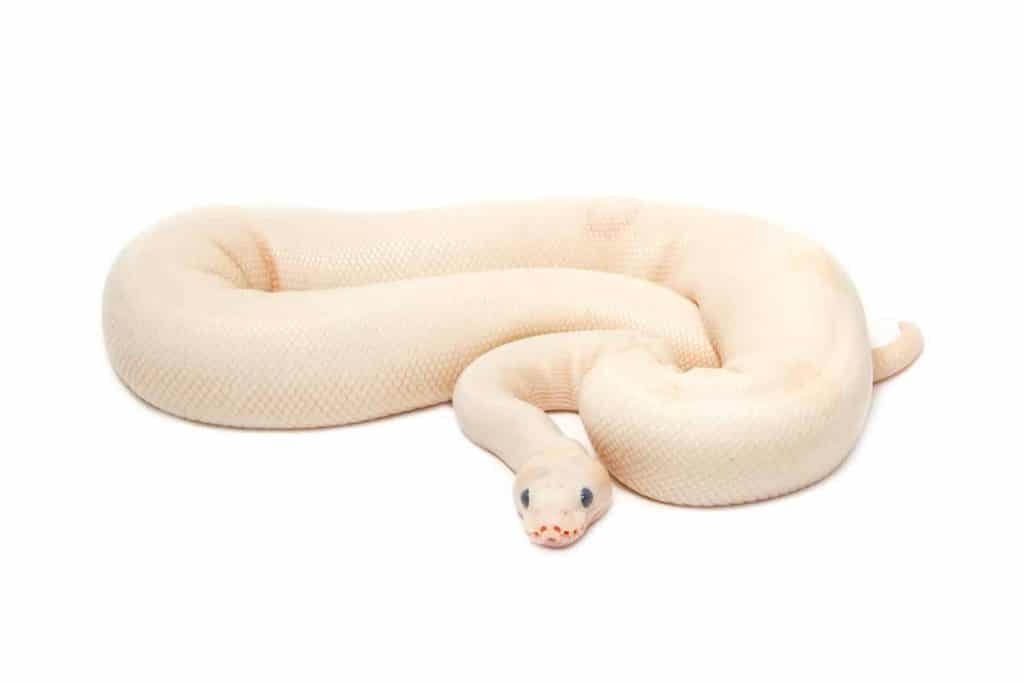
1) Albino Ball Pythons Bring a Whole New Meaning to the Slang Term “Ice”
And no, I’m not just referring to their coloring. Ball pythons also go by another name: royal pythons. They get this name by literally being worn like jewelry.
Ball pythons hail from sub-Saharan Africa. Decades ago, African royals used to wear these snakes around their necks as necklaces, or around their arms and wrists like bangles. It definitely shines a new light to the Bangles song “Walk Like an Egyptian,” doesn’t it? Apparently, you have to actually wear live, bitey bangles to walk like one.
The more common name, ball python, comes from the snake’s tendency to curl up into a ball when threatened. Much less exciting than wrapping itself around the neck of a corrupt king, I know, but what can I say?
Ball pythons are considered so royal that to the Igbo people in Nigeria, they are almost worshiped. The Igbos rely a lot on the land, and ball pythons are seen as a symbol of the earth since they travel so close to the ground.
The snakes are allowed to roam free, never barred from anywhere (or else carefully and reverently removed), and if one is ever accidentally killed, the Igbo people actually build a small coffin for the body and hold a short funeral.
2) Albino Ball Pythons Aren’t Always White
Although the classic white and yellow coloring of this snake is the most popular and common of the albino ball pythons, other pale colorations of this snake exist and are arguably even more beautiful.
The one you’re probably thinking of is lovingly referred to as the T-Albino, for no discernible reason, as the T stands for absolutely nothing. Other, less cleverly named, albinos go by the names lavender albino ball pythons, high contrast albino ball pythons, and caramel albino ball pythons, just to name a few.
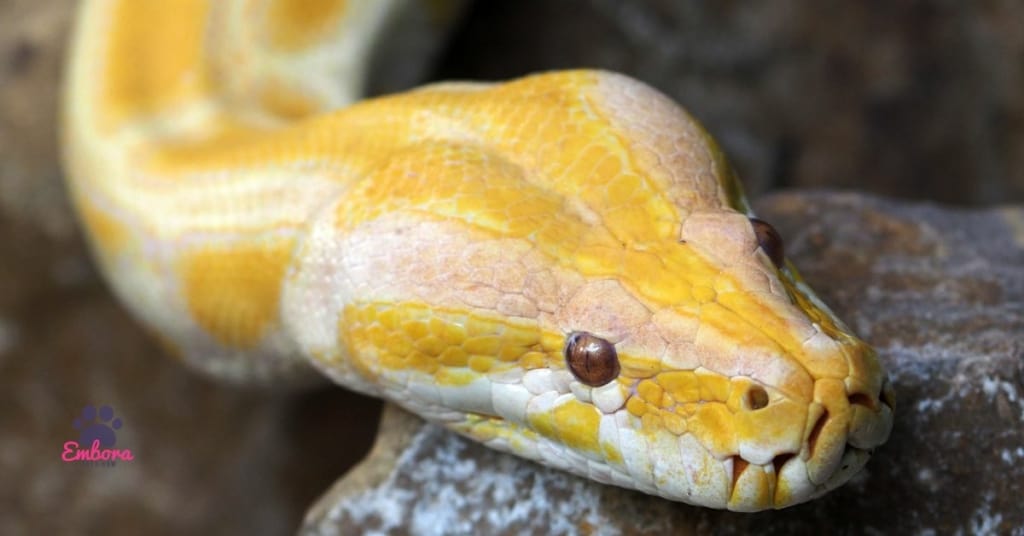
Besides the fact that there are other, non-white sub-species of “albino” ball pythons, there is, of course, the glaring problem that even the T-Albinos are not completely white. They are covered in spots ranging from pale yellow to sunset orange.
I don’t know about you, but the last time I went out into the rainforest in a white body suit covered in bright orange dots, I definitely wasn’t blending in. Maybe that’s why there are so few albino pythons found in the wild. After all, the more flashy a predator’s meal is, the more they’re going to want to eat it.
Expert Tip & Trivia on Albino Ball Pythons:
One expert tip or little-known fact about Albino Ball Pythons is that they are sensitive to bright lights and UV radiation. As they lack the melanin pigment that provides protection against UV radiation, it is important to provide them with a suitable environment that minimizes their exposure to bright lights and UV radiation.
Albino Ball Pythons do best in low light and low UV environments, so it is essential to use appropriate lighting and/or UV blocking materials when setting up their enclosure. Additionally, Albino Ball Pythons are also prone to health issues, such as eye and skin problems, which can be caused by exposure to bright lights and UV radiation, so it is important to monitor them closely and take action if necessary to address any health concerns.
3) Sometimes, Albinos Are Quitters
T-albino ball pythons are always born brilliantly white with pale, usually yellow colored spots. They are typically born into two categories: high contrast albinos and low contrast albinos. High contrast albinos will keep their white body, while low contrast albinos will fade to a pale yellow that covers their entire body.
As mentioned before, there are other colors of albino ball pythons, ranging from lavender to cinnamon (you can tell a Scentsy fanatic probably named them; I would have just called them purple and red snakes, but I’m a blogger, not a scientist). These variations are not as common as the high and low contrast albinos.
4) Being Albino Isn’t Actually All That Rare
Albino ball pythons are a “naturally occurring color morph” of your average ball python. In fact, they are even the best-known sub-species of the ball pythons. Out of the entire family of pythons, the only known extensive color forms have been with ball pythons.
Of course, the albino coloring is passed down genetically from parent to child, just like your skin color came from your parents and will continue on to your child. It’s just not an abnormality for these ball pythons to be albino, even though it scientifically qualifies as a genetic disorder.
That being said, this particular form of scale color wasn’t really around until quite recently. Albino ball pythons have only been causing a stir since around 1990, and since then, they’ve only been showing up more and more.
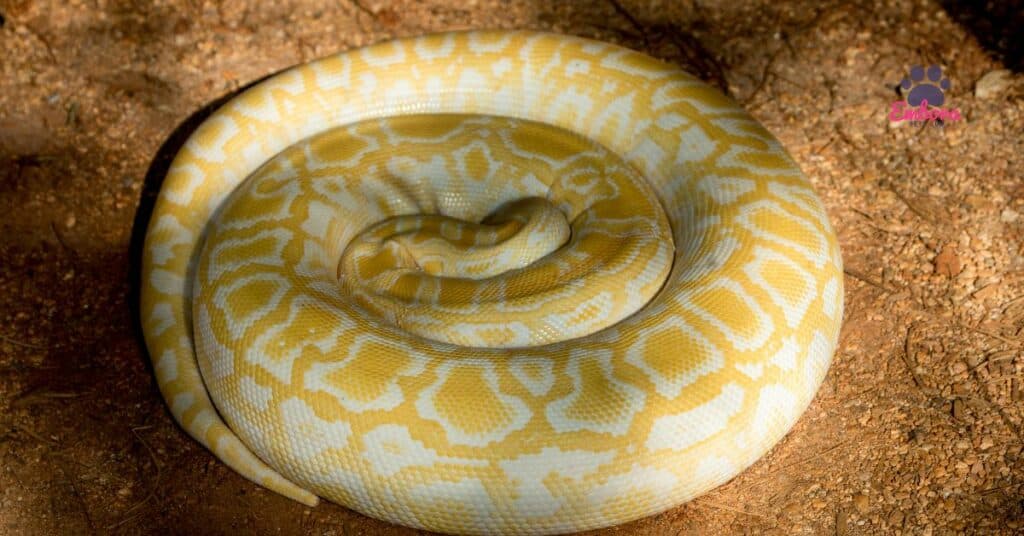
Kind of like how once you notice one spot of dirt on your carpet, you can’t help but keep finding them around, even though you’re absolutely positive you vacuumed that square inch about a dozen times. There are other species of snake that have albino types as well!
[We recently wrote an article about albino corn snakes that includes awesome pictures and facts.]
5) It’s Okay to Put a Label on Albinos
Albino ball pythons are something called “
You probably have a freckle or two. If you don’t, you might have a darker skin tone. Freckles and darker skin tones are just evidence of more melanin in your body. Exposure to sunlight stimulates melanin production, which is why you freckle or tan during the summer (I, unfortunately, do neither, and instead turn a delightful shade of ruby red).
A normal person, or snake, naturally produces melanin in their bodies, though at differing rates and to varying lengths. When your body cannot produce melanin, then you are what is labeled as “albino” or “
Albino ball pythons fall under this label. They are pale, with lighter colored spots, and their eyes and tongue are pink. Don’t worry, it’s not unhealthy at all, and they still live long lives.
6) Albino Ball Pythons Are Not Rabbits…
This is obvious. You must be thinking Why exactly did I come to read this article is it’s just going to tell me things I could have asked a kindergartener? What I really mean to say is that they don’t get as busy as rabbits do (cough cough, wink wink).
Although ball pythons are classified on the IUCN Red List for Endangered Species under the heading “Least Concern,” they don’t reproduce very often. Ball pythons don’t reach sexual maturity until they are about two to three and a half years of age. And once they get there, it still takes an entire year to complete the whole breeding process.
If you’re patient enough to work through that whole year, you’ll be lucky if any of the eggs are fertile at all, as they have an unusually high tendency of being infertile. To top it all off, if the breeding conditions and environment aren’t exactly to the ball pythons’ taste, they might not even produce eggs at all.
In the unlikely event that all those hurdles have been properly surmounted, the ball pythons will produce (hopefully) a grand total of four eggs. Just the four. Probably. I know, not exactly super rewarding. It’s a wonder and a miracle albino ball pythons have managed to hang on this long, let alone keep a seat warm in the “Least Concern” category.
When the eggs are laid, the mother curls around her eggs, protecting them and keeping them warm. The incubation period can last anywhere from 60 to 105 days.
7) They are Individually Unique, Like Snowflakes
If at this point, you feel like vacating your computer desk and having a nice, long conversation with a four-year-old, be my guest. I’ll wait.
You back? Alright, let’s keep this ball rolling. Albino ball pythons are exactly like snowflakes in the same way that they are nothing like romance novels. That is, each one is actually different.
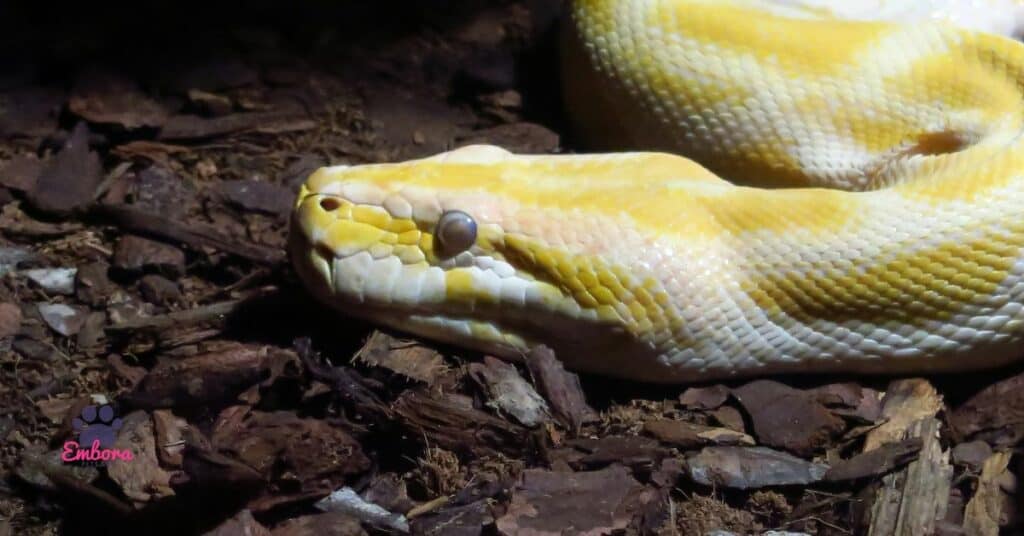
The scales on an albino ball python, or any snake for that matter, act much like a fingerprint. Each one is unique to the snake and can be used as identification. If you had two or three snakes you would probably want to name them, and would then need to have a way of telling them apart.
Perhaps you’ll call one Spot because you’re unoriginal and uncreative. Or maybe you’ll call one Bandit because of the distinct markings around their eyes. The point is, because of their clearly different markings, you can easily tell these snakes apart, even if they’re from the same species.
8) Their Movement is Unique
Ball Pythons have a highly unusual way of getting around. It’s call “rectilinear movement.”
Imagine for a second that you have no legs or arms. Actually, don’t imagine that. I want you to get up, lay down on the ground, with legs together and arms pressed to your sides, and roll around like a log. Try and get from your computer to the kitchen.
I bet that you probably placed yourself directly in line with the kitchen door- eyeing the runway like a professional golfer- laid down perfectly straight, started rolling, and then somehow ended up running right into the couch (I take no responsibility for any incurring bruises; after all, I’m just a voice in your head that you’re using in order to read the text on your screen).
Ball pythons, much like you in this log rolling experiment, cannot proceed in a straight line, a dilemma made worse by the fact that they have an unusually wide body. If they got pulled over by a cop, they’d be in big trouble. As you can imagine, being unable to go directly where you want to go can be annoying, especially if you haven’t eaten in a week and you’ve just spotted a tasty meal.
To fix this, ball pythons use rectilinear movement, which is basically a very fancy word for how inchworms move (next time you want to sound sophisticated, I suggest whipping this word out of your arsenal). They shove a small section of their body into the ground and use their belly muscles to push the rest of their body forward. Inchworms do something very similar, except instead of shoving their body down, they shove it up.
9) Ball Pythons Are the Short Ones of the Family
Most members of the python family are huge, and many commonly grow to be as long as a three-story building is tall. Sadly, ball pythons missed that genetic train, and got stuck with the shrimpy end of the stick.
Ball pythons, albinos included, only grow to about three feet in length, or five feet if they’re lucky. Hatchlings usually emerge at around a foot long and stop growing about three years later, when they reach sexual maturity.
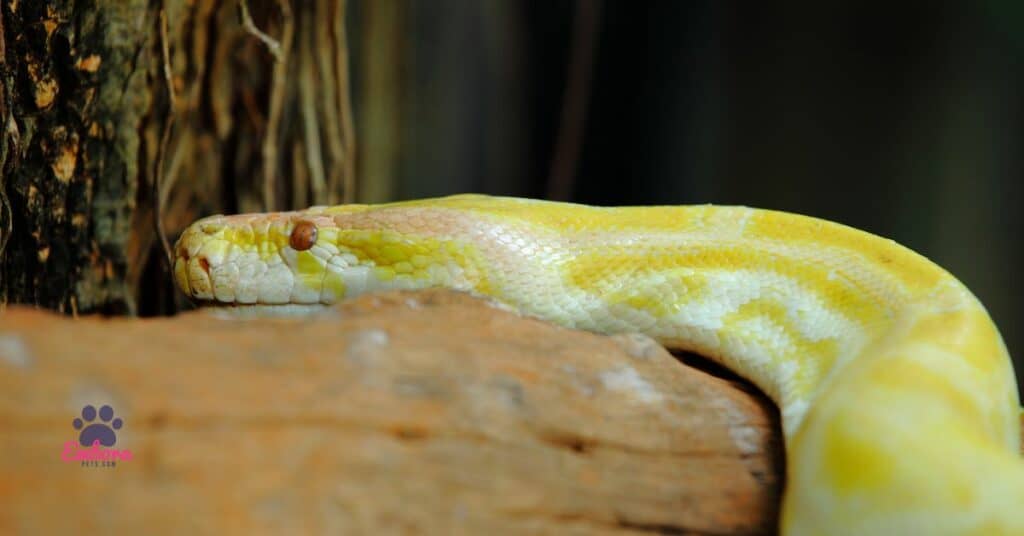
Females are slightly bigger than males, which makes sense, considering who have to carry four babies at once.
10) They’ll Probably Outlive Your Dog… and His Children… and Grandchildren
In the wild, albino ball pythons live to around the age of 12. This alone is a pretty good feat, considering how brightly colored they are. However, in captivity, these snakes live an average of 30 years! The oldest ball python ever to live in captivity was 47 years and six months old when he died.
11) Albinos Are Ground Breaking in Recessive Genes
Albino ball pythons were actually the first proven recessive mutation of the ball python species. If it’s been a while since your ninth-grade biology class, a recessive gene is a gene that is often times dominated by other genes.
For example, blue eyes are recessive, which is why there are are a lot more brown eyed people than blue-eyed people. It takes just the right combination of genes and just the right timing for a recessive gene to win out.
Because being an albino is a recessive trait, you wouldn’t expect albino ball pythons to show up very often. However, once they showed up, snake enthusiasts, especially breeders, took an excessive interest in them. They began breeding albinos with a vigor not seen in the breeding world since the discovery of the mule.
Once this “breeding fever” took hold, albino ball pythons were everywhere. They quickly became a popular and common choice for people looking to own a pet snake, and consequently, albino ball pythons are relatively cheap.
There is actually a market for snakes called “designer morphs.” This just means that a breeder has specifically selected certain snakes in order to produce a desired pattern or color in the offspring. Although being an albino snake is supposed to be rare and an abnormality, breeders have almost treated them as designer morphs, constantly breeding albino ball pythons in the hope of creating an even more stunning second generation.
12) Ball Pythons Give Free Hugs
When you think “constrictor,” your brain probably jumps straight to a boa constrictor. Though boa constrictors do share commonalities with our beloved albino ball python, they probably wouldn’t match on a Tinder account.
A constrictor is just the technical term attributed to snakes that wrap themselves around their prey, squeeze them to death, then swallow them whole. Contrary to popular belief, squeezing their prey does not mean they break their prey’s bones, or that they suffocate their prey. Constrictors simply overwhelm the circulatory system, depriving their prey’s brain of oxygen, and killing them in seconds.
After their prey is dead, ball pythons swallow it whole, starting with the head. They take a few days to fully digest their prey, and in the immediate 24 hours after eating, you’ll probably find them relaxing in the warm sun, sporting a fairly impressive lump right around their middle that looks suspiciously like Jerry. Looks like Tom finally found himself a business partner.
Suggested Reading:
Be sure to check out our highly popular article on Breeds of Ball Pythons Morphs.
13) Albino Ball Pythons Are Probably the Best Pet for You
You’ve made it to unlucky number 13. But I saved the best for last, don’t worry.
Snakes in general are pretty good pet, seeing as you only have to feed them about once a week, and you rarely have to pay for them to visit the vet. You never have to take them outside on walks, and pooper-scooper duty only consists of the few minutes it takes to change out the newspaper lining the bottom of the enclosure.
Besides their attractive color, albino ball pythons are widely thought of as the best breed of snake to get for beginners and experts alike. Ball pythons are small, meaning their enclosure won’t take up much space. In addition, they are ground snakes and don’t require a tall terrarium, preferring, long, low living spaces. Plus, in a fabulous twist of fate, ball pythons are non-venomous!
Docile, adaptable, and small, ball pythons are the ideal snake for a household with children. They are unlikely to strike when being fed and are one of the few snakes that actually seem to enjoy being held. They are easy to handle, live for a long time, and are readily available.
Although albino snakes are not as common as a normal ball python, I would recommend getting one if you are looking for a pet snake, as I am sure many snake enthusiasts would as well. Their beautiful scales combined with their winning attitude make them close to number one in my book.
Related Questions
Can ball pythons be dangerous?
Ball pythons are non venomous, and actually usually strike with a closed mouth. However, they can deliver a nasty bite if antagonized, despite being extremely docile.
How long can a ball python go without eating?
Ball pythons typically eat every seven to ten day. Sometimes, of their own volition, they will just stop eating altogether, and will occasionally refuse for upwards of a month or two; in the wild, it is not hugely uncommon for a ball python to go six months without eating. If your snake won’t eat, don’t panic, and just keep offering food. You only need to start worrying if you start being able to see their ribs.
Are pythons aggressive?
Pythons are usually docile and rarely bite. Snakes captured in the wild may have a hard time adjusting. They might refuse food and lash out if you try to pick them up. If you have a wild snake, give them a few days to settle in before you start to try to handle them.
